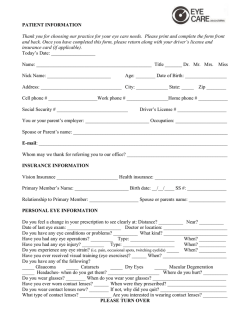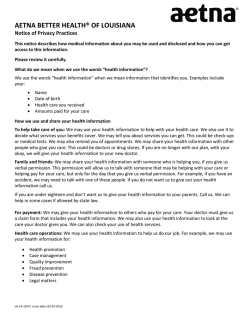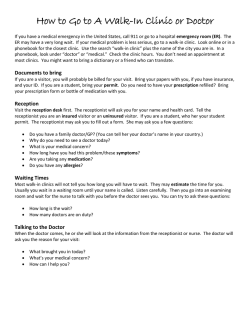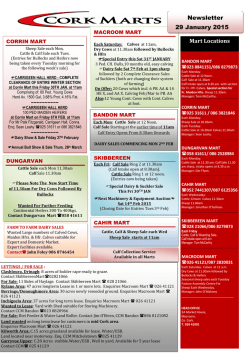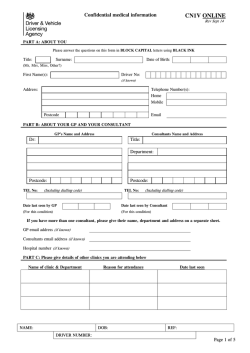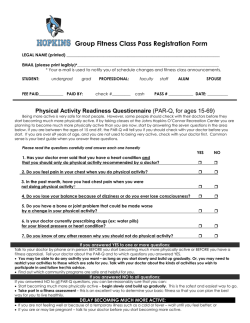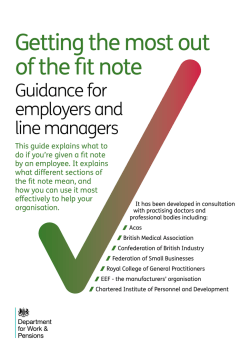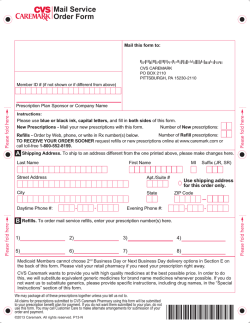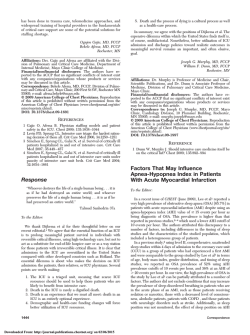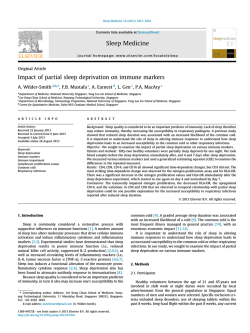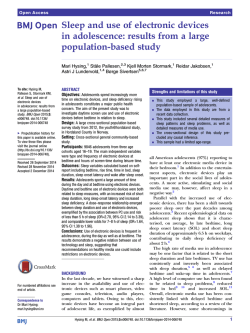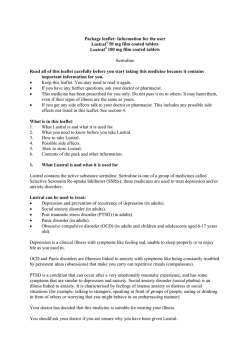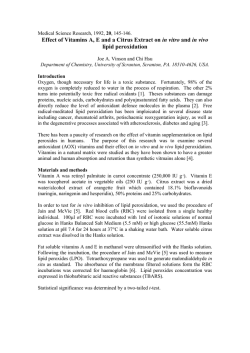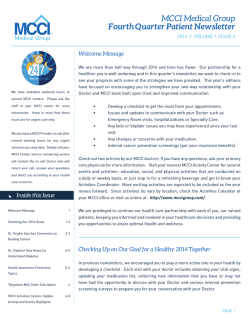
Newsletter February 2015
H E A L T H FREE • Take One February 2015 Heart Health Month THE DRUG STORE NORWAY PHARMACY CRYSTAL FALLS PHARMACY 1112 S. Stephenson Ave. Iron Mountain, MI 49801 514 Main Street Norway, MI 49870 1340 W US 2 Crystal Falls, MI 49920 Phone: (906) 774-3654 Fax: (906) 774-1044 Hours: Mon-Fri 8am-9pm • Sat 9am-5pm • Sun 10am-5pm Phone: (906) 563-5151 Fax: (906) 563-5978 Hours: Mon-Fri 9am-6pm • Sat 9am-3pm • Sun Closed FREE Local Delivery Phone: (906) 875-3601 Fax: (906) 875-3604 Hours: Mon-Fri 8am-6pm • Sat 9am-3pm • Sun Closed HM835794 LOVE YOUR HEART Keep It Healthy! WHAT’S INSIDE Vitamin C: How Much Do You Need? Senior Health Update: Age-Related Vision Problems How to Create Your Complete Health History 2 3 4 Getting answers from your doctor to these important questions will give you vital information about your heart health and what you can do to improve it. You may want to take this list to your doctor’s office: 1. What is my risk for heart disease? 2. W hat is my blood pressure? What does it mean for me, and what do I need to do about it? 6. W hat other screening tests for heart disease do I need? 7. How can you help me quit smoking? 8. H ow much physical activity do I need to help protect my heart? 9. W hat is a heart-healthy eating plan for me? Should I see a registered dietitian? 10. How can I tell if I’m having a heart attack? 3. What are my cholesterol numbers? —Source: National Institutes of Health 4. W hat are my body mass index (BMI) and waist measurement? Do I need to lose weight for my health? 5. W hat is my blood-sugar level? Am I at risk for diabetes? Your Child’s Cold Try These Safe and Effective Treatments Obstructive Sleep Apnea What Is It? Research has shown that cold and cough products offer little benefit to young children — and can have potentially serious side effects. Cold and cough products for children under age 4 have been removed from store shelves. So without these over-the-counter medicines, what’s the best way to treat your toddler’s cold? Obstructive sleep apnea (OSA) occurs when the tissue in the back of the throat collapses during sleep. This keeps air from getting into the lungs. This is very common, because the muscles inside the throat relax as you sleep. Gravity then causes the tongue to fall back and block the airway. It can happen a few times a night or several hundred times per night. These pauses in breathing briefly wake you up and disturb your sleep. This can cause you to be very tired the next day. People who are overweight are at a higher risk of having sleep apnea. Acetaminophen or ibuprofen can reduce aches and pains, and a coolmist vaporizer can help loosen congestion. A simple bulb syringe and saline nasal spray can be used to clear stuffy noses. Plenty of liquids, especially chicken soup, and rest also help children feel better. Also, don’t underestimate the power of TLC. Your loving care is one of the best medicines for your child. If you are having daytime tiredness and feel you are not sleeping well for any reason, talk with your doctor about your symptoms and possible causes. In some cases, a sleep study may be recommended. — Source: American Academy of Pediatrics — Source: UCLA Sleep Disorders Center Vitamin C How Much Do You Need? The Recommended Dietary Allowance (RDA) for vitamins reflects how much of each vitamin most people should get each day. The best way to get the daily requirement of essential vitamins is to eat a balanced diet that contains a variety of foods. Here is the RDA for vitamin C, per the National Institutes of Health: Children Adolescents Adults • 1–3 years: 15 mg/day • 4–8 years: 25 mg/day • 9–13 years: 45 mg/day • • • • • • • • Girls 14–18 years: 65 mg/day Pregnant teens: 80 mg/day Breastfeeding teens: 115 mg/day Boys 14–18 years: 75 mg/day Men age 19 and older: 90 mg/day Women age 19 and older: 75 mg/day Pregnant women: 85 mg/day Breastfeeding women: 120 mg/day Those who smoke need higher amounts of vitamin C. In all cases, ask your doctor what amount is best for you. — Source: National Institutes of Health HEALTH smart February 2015 2 SENIOR HEALTH UPDATE Age-Related Vision Problems As you age, so do your eyes. You might find that you have difficulty reading small print or that you need brighter lighting at your desk. In addition, eye diseases that could lead to more-serious vision problems become more common with age. Consider cataracts. A cataract is a clouding of the normally clear lens of the eye. Most cataracts develop slowly and don’t disturb eyesight early on. At first, stronger lighting and eyeglasses can help you deal with cataracts. Eventually cataracts can interfere with your vision. Left untreated, cataracts can lead to blindness. However, even with advanced cataracts, vision can usually be restored with surgery. Your Children’s Eyes When Should Eye Exams Begin? A pediatric eye exam helps detect eye problems in your child at their earliest stage — when they’re most treatable. Several factors may determine how frequently your Be sure to have regular checkups with your ophthalmologist so that any developing vision problems can be caught early. child needs an eye exam, including age, health and risk of developing eye problems. General guidelines include: • Children — Source: Mayo Clinic 5 years and younger: For children under age 3, your pediatrician will likely look for the most common eye problems — lazy eye, crossed eyes or turned-out eyes. Depending on your child’s willingness to cooperate, his or her first, more comprehensive eye exam DID YOU KNOW? should be done between the ages of 3 and 5. Diabetes and Fungal Infections • School-age children and adolescents: The culprit in fungal infections for people with diabetes is often Candida albicans. This yeast-like fungus can create itchy rashes of moist, red areas surrounded by tiny blisters and scales. Problem areas include moist folds of the skin, such as under the breasts, around the nails, between fingers and toes, in the corners of the mouth, under the foreskin (in uncircumcised men), and in the armpits and groin. Common fungal infections include jock itch, athlete’s foot, ringworm (a ring-shaped itchy patch) and vaginal infection that causes itching. If you think you have a yeast or fungal infection, call your doctor. These infections are treatable with medication. Have your child’s vision checked before he or she enters first grade. If your child has no symptoms of vision problems and you don’t have a family history of vision problems, have your child’s vision re-checked every two years. If your child does have vision problems or a family history of vision problems, have your child’s vision re-checked as advised by your eye doctor. — Source: Mayo Clinic — Source: American Diabetes Association 3 HEALTH smart February 2015 HEALTH MART IS YOUR LOCALLY OWNED COMMUNITY PHARMACY We offer all the benefits of national chains with the highly personalized care you expect from a family-run business. See how we’re making a real difference every day. www.healthmart.com/healthmartbrand PLAN ACCEPTANCE Health Mart pharmacies honor nearly all prescription plans at the same co-pay as the national chains, and our pharmacists are always here to answer any questions you have about your medications. Your Health. Your Choice. Our Brand. DEDICATED SERVICE Our pledge to you: care, quality, value, expertise and dedication. EVERYDAY SAVINGS Because your locally owned, award-winning, customer servicefocused Health Mart is part of a nationwide network of community pharmacies, you will find everyday low prices on all prescription and over-the-counter products. Not only does your Health Mart pharmacy have the brand names you want, it also offers a wide range of generics and over-the-counter products, including the best selection of Health Mart brand products. Living with Arthritis? Try These Tips If you have arthritis, you want to avoid or reduce pain and stress on your joints. The American Occupational Therapy Association suggests using carts or carriers with wheels to move garbage cans, grocery bags, laundry YOU AND YOUR DOCTOR and other heavy items so you don’t have to How to Create Your Complete Health History lift them. Use suitcases with wheels. Replace When you visit a new doctor, you are often asked to give a “complete health history.” But who can think of everything in the waiting room while waiting to see the doctor? It’s best to plan in advance and to have this information handy. You may want to prepare a written health history for this and future visits. Then you can just keep updating it for future use. ing and drug use, immunizations, and family history of disease. lever-style handles. Wrap foam, cloth or tape You may also want to bring appropriate past medical records, X-rays or test results with you. You will need the names and contact information for past healthcare providers if you want to ask the new doctor to request your past medical records. To do that, you will need to sign a form giving permission for their release. and pots and pans to cushion the grip. Use Include information on illness and injuries, hospitalizations, surgical procedures, medications, allergies (including allergies to drugs and foods), exercise habits, diet (including alcohol use), harmful behaviors such as smok- HEALTH smart February 2015 —Source: The American College of Obstetricians and Gynecologists 4 round doorknobs and faucet handles with around the handles of objects such as knives household and gardening tools with larger, ergonomically designed handles. —Source: The American Occupational Therapy Association, Inc. Health Mart’s Health Smart newsletter is not intended as medical, legal or regulatory advice. The information provided is intended to educate and inform. Please consult with your physician or other licensed professional for advice. Health Mart and its affiliates and member pharmacies disclaim all liability arising from or related to reliance on information contained in Health Mart’s Health Smart newsletter.
© Copyright 2025

